Critique and Comparison of Two Discussion Papers on Tourism Planning and Development
VerifiedAdded on 2023/06/09
|9
|2282
|482
AI Summary
This article critiques and compares two discussion papers on tourism planning and development, focusing on policy planning cycle, content, strengths, and weaknesses. The papers cover topics such as climate change policies, Indigenous tourism, destination images, and more.
Contribute Materials
Your contribution can guide someone’s learning journey. Share your
documents today.
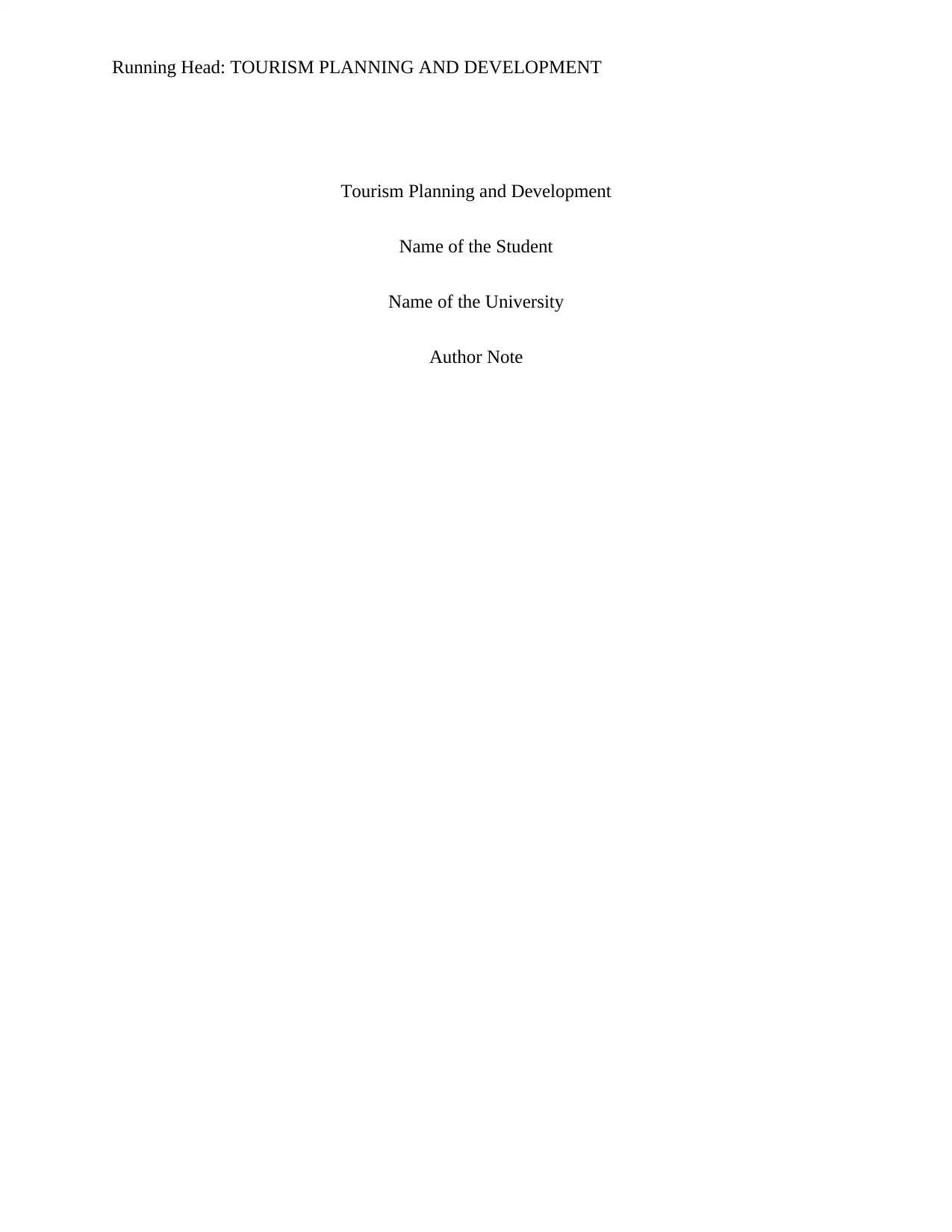
Running Head: TOURISM PLANNING AND DEVELOPMENT
Tourism Planning and Development
Name of the Student
Name of the University
Author Note
Tourism Planning and Development
Name of the Student
Name of the University
Author Note
Secure Best Marks with AI Grader
Need help grading? Try our AI Grader for instant feedback on your assignments.
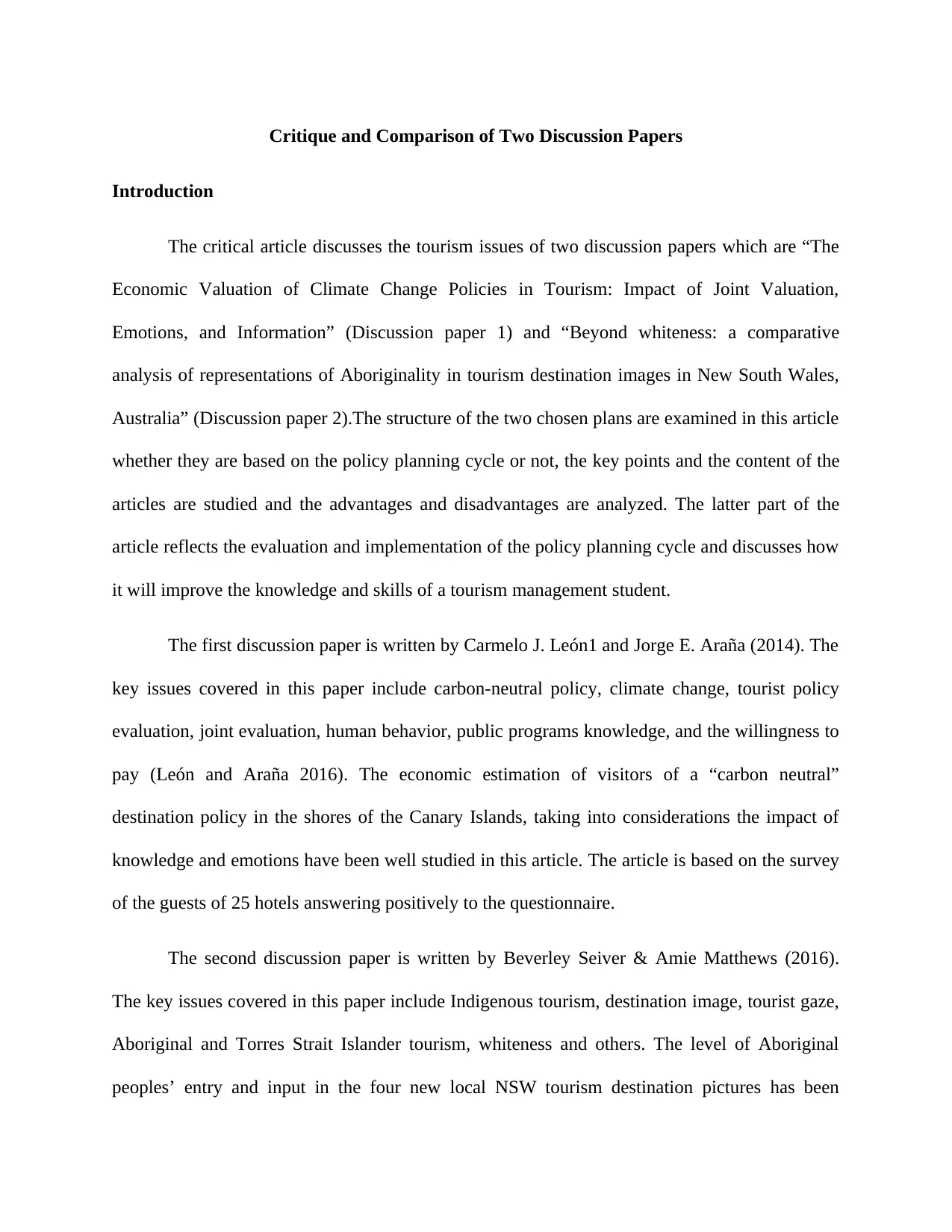
Critique and Comparison of Two Discussion Papers
Introduction
The critical article discusses the tourism issues of two discussion papers which are “The
Economic Valuation of Climate Change Policies in Tourism: Impact of Joint Valuation,
Emotions, and Information” (Discussion paper 1) and “Beyond whiteness: a comparative
analysis of representations of Aboriginality in tourism destination images in New South Wales,
Australia” (Discussion paper 2).The structure of the two chosen plans are examined in this article
whether they are based on the policy planning cycle or not, the key points and the content of the
articles are studied and the advantages and disadvantages are analyzed. The latter part of the
article reflects the evaluation and implementation of the policy planning cycle and discusses how
it will improve the knowledge and skills of a tourism management student.
The first discussion paper is written by Carmelo J. León1 and Jorge E. Araña (2014). The
key issues covered in this paper include carbon-neutral policy, climate change, tourist policy
evaluation, joint evaluation, human behavior, public programs knowledge, and the willingness to
pay (León and Araña 2016). The economic estimation of visitors of a “carbon neutral”
destination policy in the shores of the Canary Islands, taking into considerations the impact of
knowledge and emotions have been well studied in this article. The article is based on the survey
of the guests of 25 hotels answering positively to the questionnaire.
The second discussion paper is written by Beverley Seiver & Amie Matthews (2016).
The key issues covered in this paper include Indigenous tourism, destination image, tourist gaze,
Aboriginal and Torres Strait Islander tourism, whiteness and others. The level of Aboriginal
peoples’ entry and input in the four new local NSW tourism destination pictures has been
Introduction
The critical article discusses the tourism issues of two discussion papers which are “The
Economic Valuation of Climate Change Policies in Tourism: Impact of Joint Valuation,
Emotions, and Information” (Discussion paper 1) and “Beyond whiteness: a comparative
analysis of representations of Aboriginality in tourism destination images in New South Wales,
Australia” (Discussion paper 2).The structure of the two chosen plans are examined in this article
whether they are based on the policy planning cycle or not, the key points and the content of the
articles are studied and the advantages and disadvantages are analyzed. The latter part of the
article reflects the evaluation and implementation of the policy planning cycle and discusses how
it will improve the knowledge and skills of a tourism management student.
The first discussion paper is written by Carmelo J. León1 and Jorge E. Araña (2014). The
key issues covered in this paper include carbon-neutral policy, climate change, tourist policy
evaluation, joint evaluation, human behavior, public programs knowledge, and the willingness to
pay (León and Araña 2016). The economic estimation of visitors of a “carbon neutral”
destination policy in the shores of the Canary Islands, taking into considerations the impact of
knowledge and emotions have been well studied in this article. The article is based on the survey
of the guests of 25 hotels answering positively to the questionnaire.
The second discussion paper is written by Beverley Seiver & Amie Matthews (2016).
The key issues covered in this paper include Indigenous tourism, destination image, tourist gaze,
Aboriginal and Torres Strait Islander tourism, whiteness and others. The level of Aboriginal
peoples’ entry and input in the four new local NSW tourism destination pictures has been
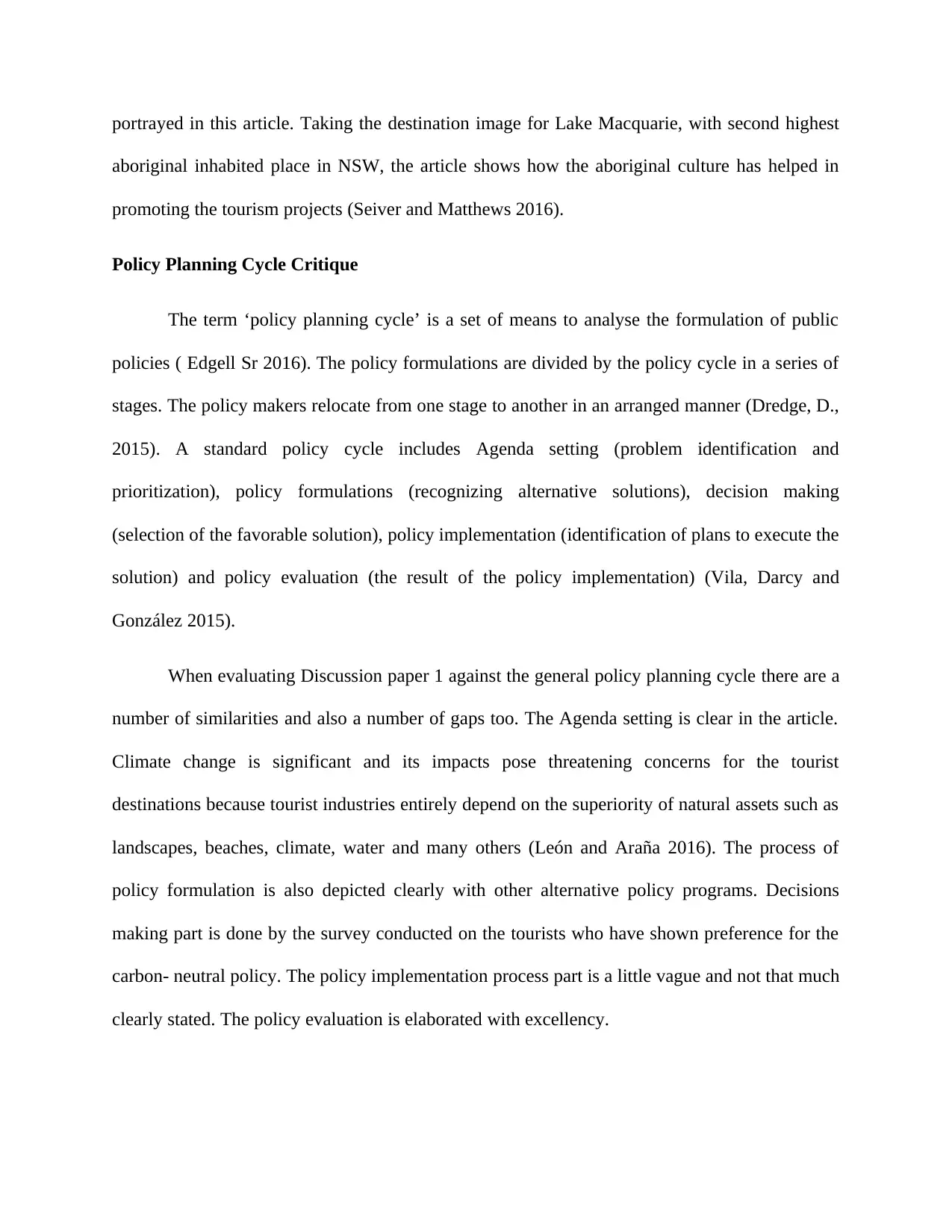
portrayed in this article. Taking the destination image for Lake Macquarie, with second highest
aboriginal inhabited place in NSW, the article shows how the aboriginal culture has helped in
promoting the tourism projects (Seiver and Matthews 2016).
Policy Planning Cycle Critique
The term ‘policy planning cycle’ is a set of means to analyse the formulation of public
policies ( Edgell Sr 2016). The policy formulations are divided by the policy cycle in a series of
stages. The policy makers relocate from one stage to another in an arranged manner (Dredge, D.,
2015). A standard policy cycle includes Agenda setting (problem identification and
prioritization), policy formulations (recognizing alternative solutions), decision making
(selection of the favorable solution), policy implementation (identification of plans to execute the
solution) and policy evaluation (the result of the policy implementation) (Vila, Darcy and
González 2015).
When evaluating Discussion paper 1 against the general policy planning cycle there are a
number of similarities and also a number of gaps too. The Agenda setting is clear in the article.
Climate change is significant and its impacts pose threatening concerns for the tourist
destinations because tourist industries entirely depend on the superiority of natural assets such as
landscapes, beaches, climate, water and many others (León and Araña 2016). The process of
policy formulation is also depicted clearly with other alternative policy programs. Decisions
making part is done by the survey conducted on the tourists who have shown preference for the
carbon- neutral policy. The policy implementation process part is a little vague and not that much
clearly stated. The policy evaluation is elaborated with excellency.
aboriginal inhabited place in NSW, the article shows how the aboriginal culture has helped in
promoting the tourism projects (Seiver and Matthews 2016).
Policy Planning Cycle Critique
The term ‘policy planning cycle’ is a set of means to analyse the formulation of public
policies ( Edgell Sr 2016). The policy formulations are divided by the policy cycle in a series of
stages. The policy makers relocate from one stage to another in an arranged manner (Dredge, D.,
2015). A standard policy cycle includes Agenda setting (problem identification and
prioritization), policy formulations (recognizing alternative solutions), decision making
(selection of the favorable solution), policy implementation (identification of plans to execute the
solution) and policy evaluation (the result of the policy implementation) (Vila, Darcy and
González 2015).
When evaluating Discussion paper 1 against the general policy planning cycle there are a
number of similarities and also a number of gaps too. The Agenda setting is clear in the article.
Climate change is significant and its impacts pose threatening concerns for the tourist
destinations because tourist industries entirely depend on the superiority of natural assets such as
landscapes, beaches, climate, water and many others (León and Araña 2016). The process of
policy formulation is also depicted clearly with other alternative policy programs. Decisions
making part is done by the survey conducted on the tourists who have shown preference for the
carbon- neutral policy. The policy implementation process part is a little vague and not that much
clearly stated. The policy evaluation is elaborated with excellency.
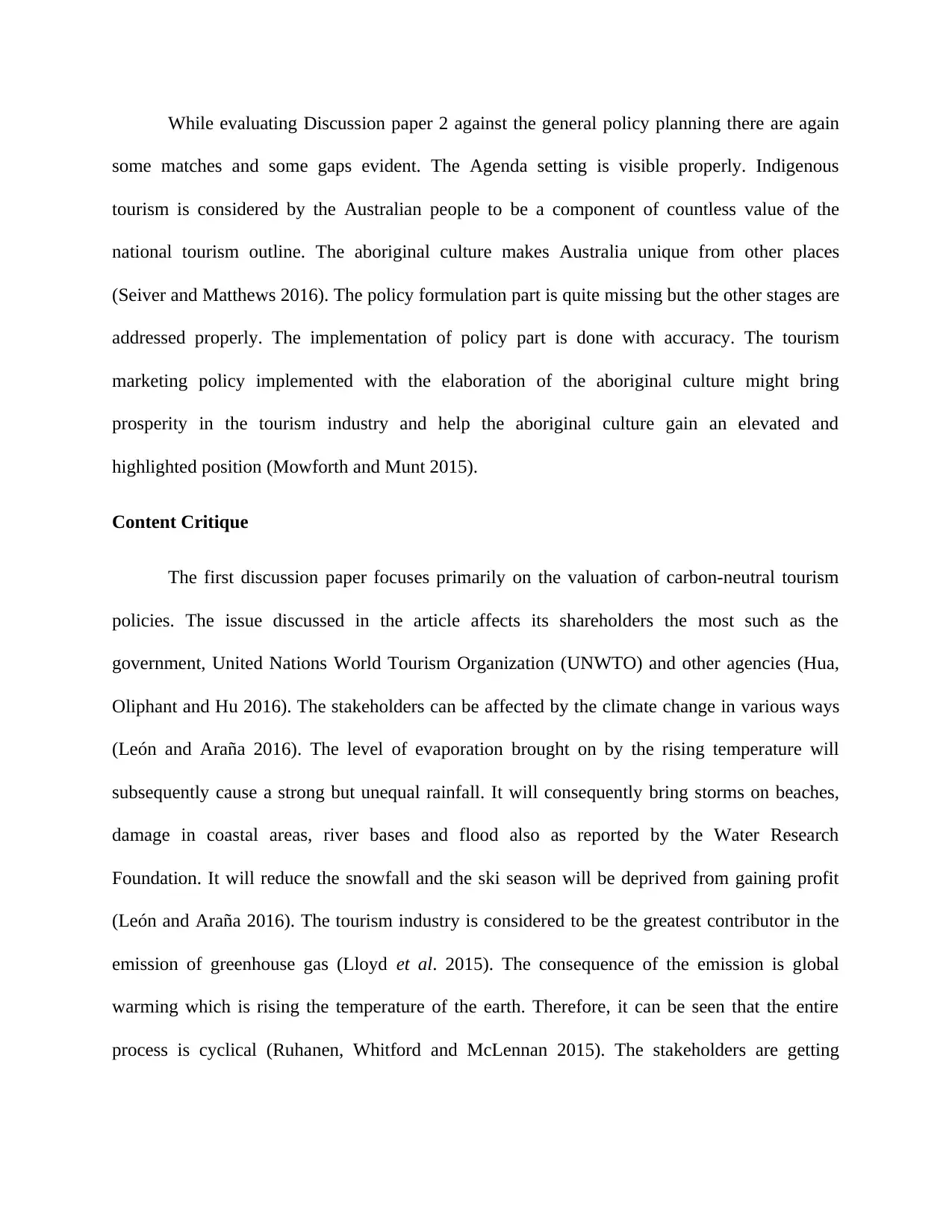
While evaluating Discussion paper 2 against the general policy planning there are again
some matches and some gaps evident. The Agenda setting is visible properly. Indigenous
tourism is considered by the Australian people to be a component of countless value of the
national tourism outline. The aboriginal culture makes Australia unique from other places
(Seiver and Matthews 2016). The policy formulation part is quite missing but the other stages are
addressed properly. The implementation of policy part is done with accuracy. The tourism
marketing policy implemented with the elaboration of the aboriginal culture might bring
prosperity in the tourism industry and help the aboriginal culture gain an elevated and
highlighted position (Mowforth and Munt 2015).
Content Critique
The first discussion paper focuses primarily on the valuation of carbon-neutral tourism
policies. The issue discussed in the article affects its shareholders the most such as the
government, United Nations World Tourism Organization (UNWTO) and other agencies (Hua,
Oliphant and Hu 2016). The stakeholders can be affected by the climate change in various ways
(León and Araña 2016). The level of evaporation brought on by the rising temperature will
subsequently cause a strong but unequal rainfall. It will consequently bring storms on beaches,
damage in coastal areas, river bases and flood also as reported by the Water Research
Foundation. It will reduce the snowfall and the ski season will be deprived from gaining profit
(León and Araña 2016). The tourism industry is considered to be the greatest contributor in the
emission of greenhouse gas (Lloyd et al. 2015). The consequence of the emission is global
warming which is rising the temperature of the earth. Therefore, it can be seen that the entire
process is cyclical (Ruhanen, Whitford and McLennan 2015). The stakeholders are getting
some matches and some gaps evident. The Agenda setting is visible properly. Indigenous
tourism is considered by the Australian people to be a component of countless value of the
national tourism outline. The aboriginal culture makes Australia unique from other places
(Seiver and Matthews 2016). The policy formulation part is quite missing but the other stages are
addressed properly. The implementation of policy part is done with accuracy. The tourism
marketing policy implemented with the elaboration of the aboriginal culture might bring
prosperity in the tourism industry and help the aboriginal culture gain an elevated and
highlighted position (Mowforth and Munt 2015).
Content Critique
The first discussion paper focuses primarily on the valuation of carbon-neutral tourism
policies. The issue discussed in the article affects its shareholders the most such as the
government, United Nations World Tourism Organization (UNWTO) and other agencies (Hua,
Oliphant and Hu 2016). The stakeholders can be affected by the climate change in various ways
(León and Araña 2016). The level of evaporation brought on by the rising temperature will
subsequently cause a strong but unequal rainfall. It will consequently bring storms on beaches,
damage in coastal areas, river bases and flood also as reported by the Water Research
Foundation. It will reduce the snowfall and the ski season will be deprived from gaining profit
(León and Araña 2016). The tourism industry is considered to be the greatest contributor in the
emission of greenhouse gas (Lloyd et al. 2015). The consequence of the emission is global
warming which is rising the temperature of the earth. Therefore, it can be seen that the entire
process is cyclical (Ruhanen, Whitford and McLennan 2015). The stakeholders are getting
Secure Best Marks with AI Grader
Need help grading? Try our AI Grader for instant feedback on your assignments.
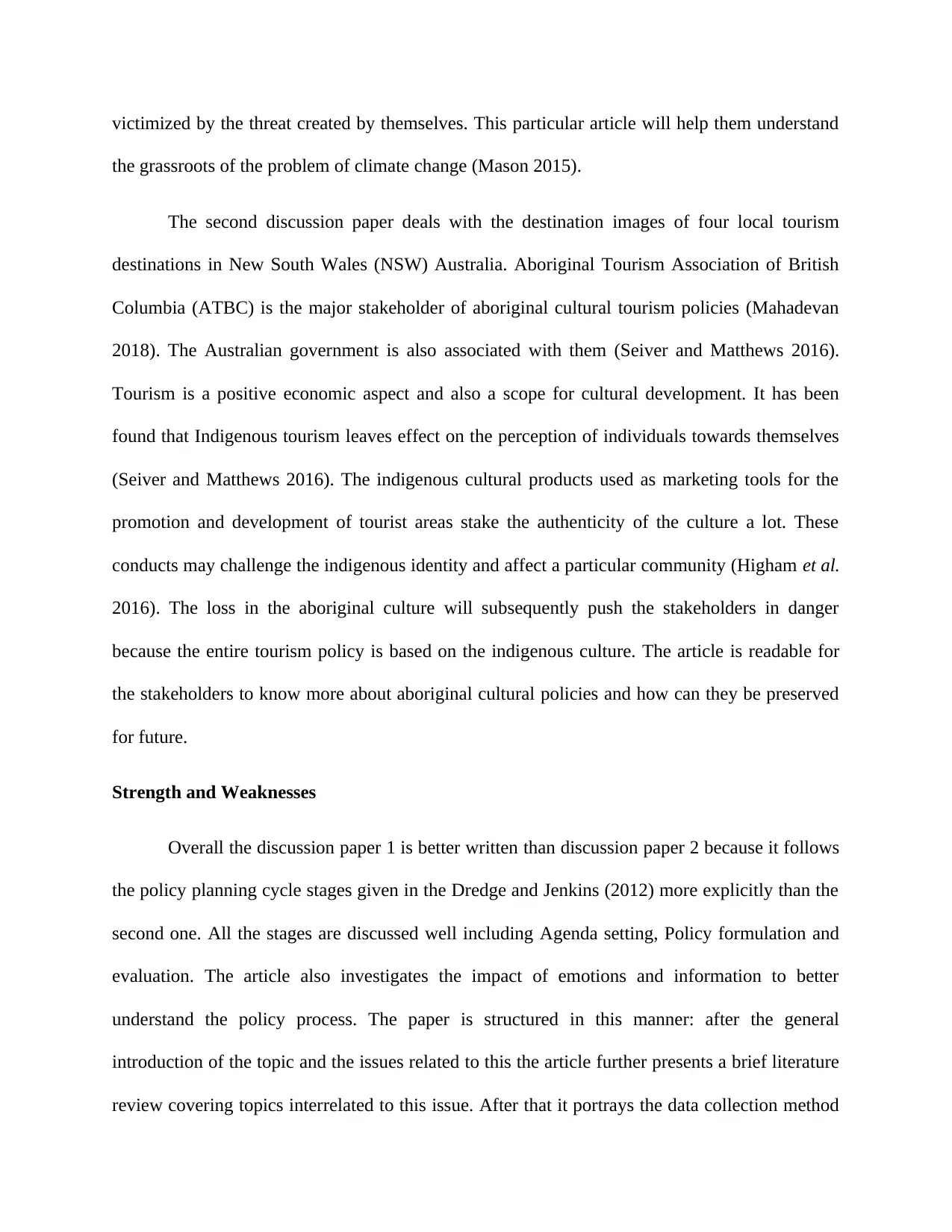
victimized by the threat created by themselves. This particular article will help them understand
the grassroots of the problem of climate change (Mason 2015).
The second discussion paper deals with the destination images of four local tourism
destinations in New South Wales (NSW) Australia. Aboriginal Tourism Association of British
Columbia (ATBC) is the major stakeholder of aboriginal cultural tourism policies (Mahadevan
2018). The Australian government is also associated with them (Seiver and Matthews 2016).
Tourism is a positive economic aspect and also a scope for cultural development. It has been
found that Indigenous tourism leaves effect on the perception of individuals towards themselves
(Seiver and Matthews 2016). The indigenous cultural products used as marketing tools for the
promotion and development of tourist areas stake the authenticity of the culture a lot. These
conducts may challenge the indigenous identity and affect a particular community (Higham et al.
2016). The loss in the aboriginal culture will subsequently push the stakeholders in danger
because the entire tourism policy is based on the indigenous culture. The article is readable for
the stakeholders to know more about aboriginal cultural policies and how can they be preserved
for future.
Strength and Weaknesses
Overall the discussion paper 1 is better written than discussion paper 2 because it follows
the policy planning cycle stages given in the Dredge and Jenkins (2012) more explicitly than the
second one. All the stages are discussed well including Agenda setting, Policy formulation and
evaluation. The article also investigates the impact of emotions and information to better
understand the policy process. The paper is structured in this manner: after the general
introduction of the topic and the issues related to this the article further presents a brief literature
review covering topics interrelated to this issue. After that it portrays the data collection method
the grassroots of the problem of climate change (Mason 2015).
The second discussion paper deals with the destination images of four local tourism
destinations in New South Wales (NSW) Australia. Aboriginal Tourism Association of British
Columbia (ATBC) is the major stakeholder of aboriginal cultural tourism policies (Mahadevan
2018). The Australian government is also associated with them (Seiver and Matthews 2016).
Tourism is a positive economic aspect and also a scope for cultural development. It has been
found that Indigenous tourism leaves effect on the perception of individuals towards themselves
(Seiver and Matthews 2016). The indigenous cultural products used as marketing tools for the
promotion and development of tourist areas stake the authenticity of the culture a lot. These
conducts may challenge the indigenous identity and affect a particular community (Higham et al.
2016). The loss in the aboriginal culture will subsequently push the stakeholders in danger
because the entire tourism policy is based on the indigenous culture. The article is readable for
the stakeholders to know more about aboriginal cultural policies and how can they be preserved
for future.
Strength and Weaknesses
Overall the discussion paper 1 is better written than discussion paper 2 because it follows
the policy planning cycle stages given in the Dredge and Jenkins (2012) more explicitly than the
second one. All the stages are discussed well including Agenda setting, Policy formulation and
evaluation. The article also investigates the impact of emotions and information to better
understand the policy process. The paper is structured in this manner: after the general
introduction of the topic and the issues related to this the article further presents a brief literature
review covering topics interrelated to this issue. After that it portrays the data collection method
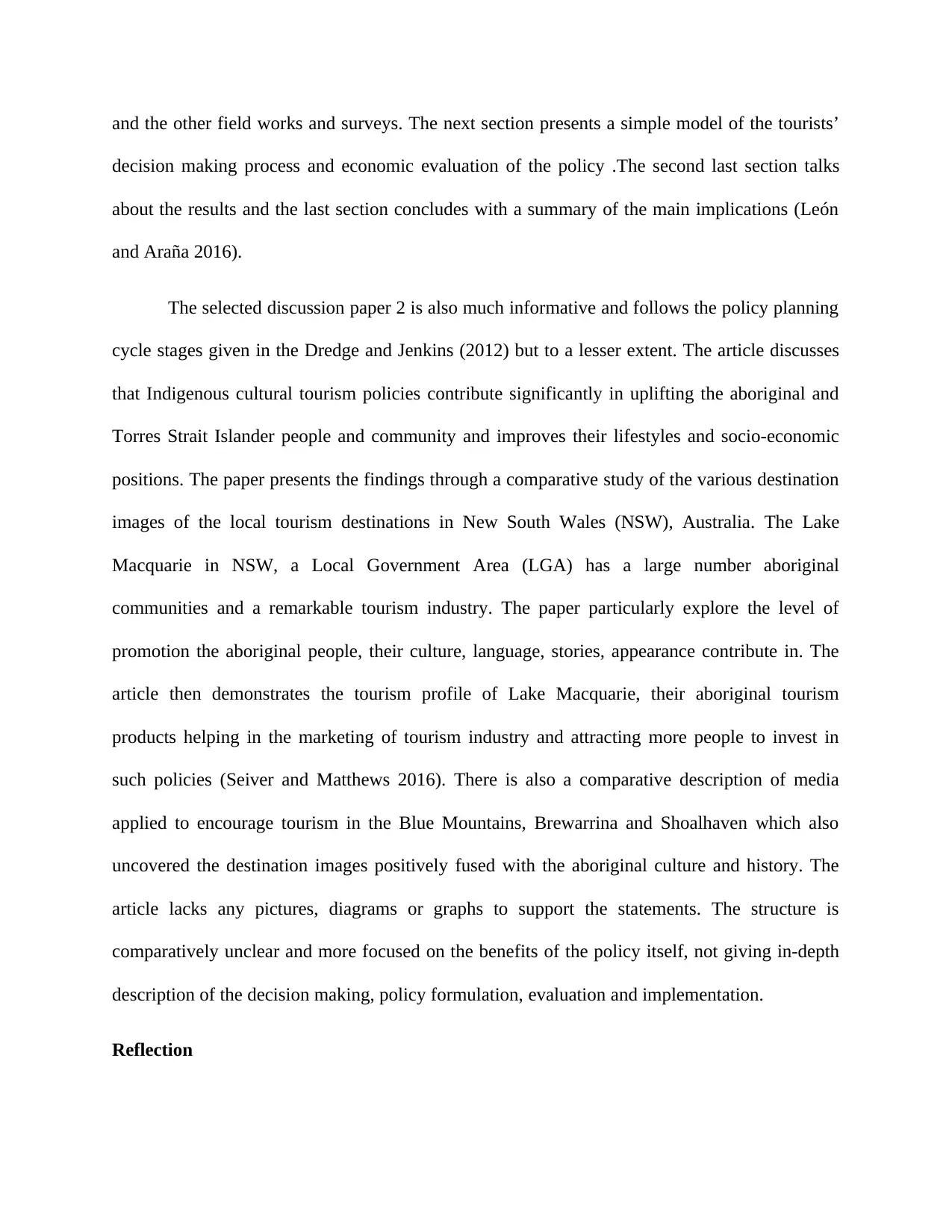
and the other field works and surveys. The next section presents a simple model of the tourists’
decision making process and economic evaluation of the policy .The second last section talks
about the results and the last section concludes with a summary of the main implications (León
and Araña 2016).
The selected discussion paper 2 is also much informative and follows the policy planning
cycle stages given in the Dredge and Jenkins (2012) but to a lesser extent. The article discusses
that Indigenous cultural tourism policies contribute significantly in uplifting the aboriginal and
Torres Strait Islander people and community and improves their lifestyles and socio-economic
positions. The paper presents the findings through a comparative study of the various destination
images of the local tourism destinations in New South Wales (NSW), Australia. The Lake
Macquarie in NSW, a Local Government Area (LGA) has a large number aboriginal
communities and a remarkable tourism industry. The paper particularly explore the level of
promotion the aboriginal people, their culture, language, stories, appearance contribute in. The
article then demonstrates the tourism profile of Lake Macquarie, their aboriginal tourism
products helping in the marketing of tourism industry and attracting more people to invest in
such policies (Seiver and Matthews 2016). There is also a comparative description of media
applied to encourage tourism in the Blue Mountains, Brewarrina and Shoalhaven which also
uncovered the destination images positively fused with the aboriginal culture and history. The
article lacks any pictures, diagrams or graphs to support the statements. The structure is
comparatively unclear and more focused on the benefits of the policy itself, not giving in-depth
description of the decision making, policy formulation, evaluation and implementation.
Reflection
decision making process and economic evaluation of the policy .The second last section talks
about the results and the last section concludes with a summary of the main implications (León
and Araña 2016).
The selected discussion paper 2 is also much informative and follows the policy planning
cycle stages given in the Dredge and Jenkins (2012) but to a lesser extent. The article discusses
that Indigenous cultural tourism policies contribute significantly in uplifting the aboriginal and
Torres Strait Islander people and community and improves their lifestyles and socio-economic
positions. The paper presents the findings through a comparative study of the various destination
images of the local tourism destinations in New South Wales (NSW), Australia. The Lake
Macquarie in NSW, a Local Government Area (LGA) has a large number aboriginal
communities and a remarkable tourism industry. The paper particularly explore the level of
promotion the aboriginal people, their culture, language, stories, appearance contribute in. The
article then demonstrates the tourism profile of Lake Macquarie, their aboriginal tourism
products helping in the marketing of tourism industry and attracting more people to invest in
such policies (Seiver and Matthews 2016). There is also a comparative description of media
applied to encourage tourism in the Blue Mountains, Brewarrina and Shoalhaven which also
uncovered the destination images positively fused with the aboriginal culture and history. The
article lacks any pictures, diagrams or graphs to support the statements. The structure is
comparatively unclear and more focused on the benefits of the policy itself, not giving in-depth
description of the decision making, policy formulation, evaluation and implementation.
Reflection
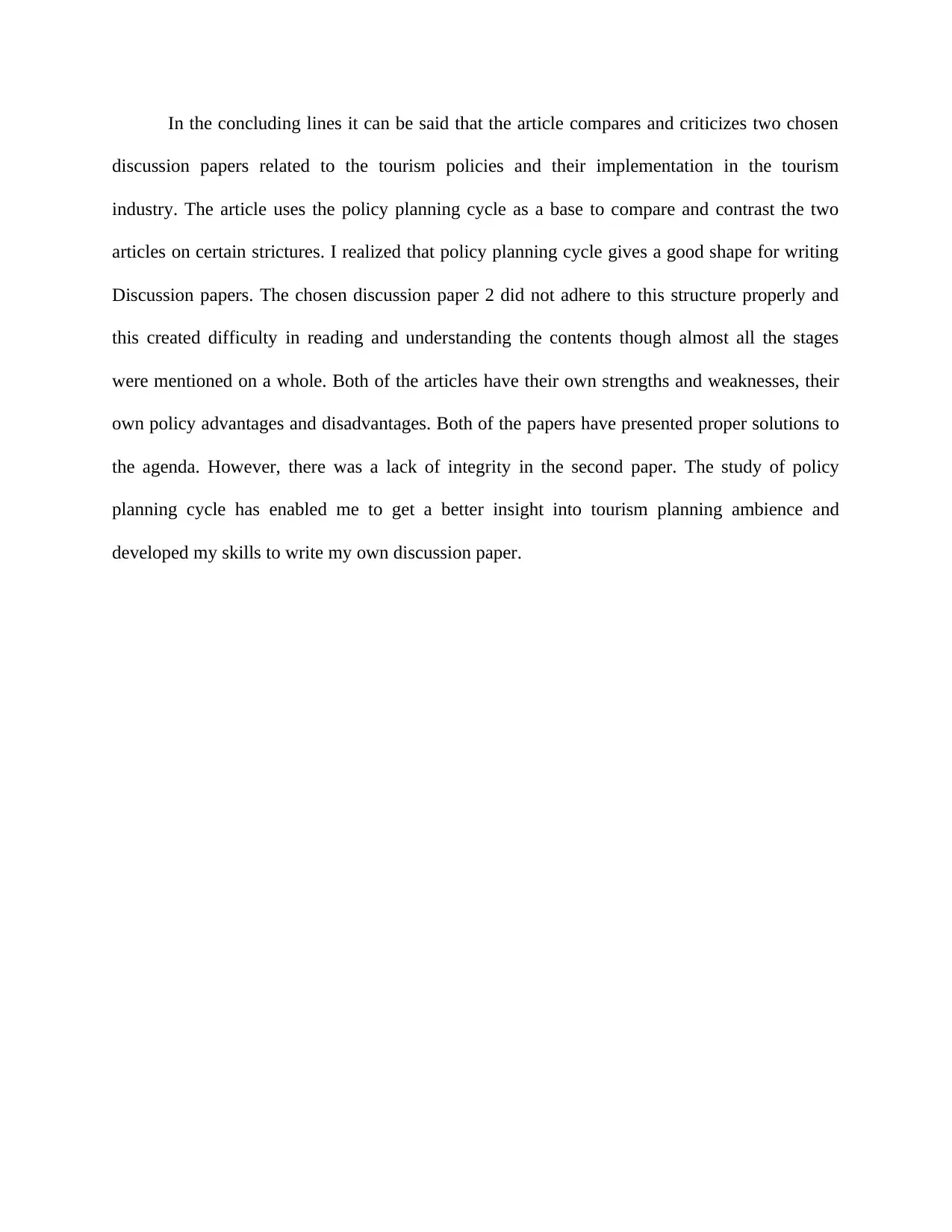
In the concluding lines it can be said that the article compares and criticizes two chosen
discussion papers related to the tourism policies and their implementation in the tourism
industry. The article uses the policy planning cycle as a base to compare and contrast the two
articles on certain strictures. I realized that policy planning cycle gives a good shape for writing
Discussion papers. The chosen discussion paper 2 did not adhere to this structure properly and
this created difficulty in reading and understanding the contents though almost all the stages
were mentioned on a whole. Both of the articles have their own strengths and weaknesses, their
own policy advantages and disadvantages. Both of the papers have presented proper solutions to
the agenda. However, there was a lack of integrity in the second paper. The study of policy
planning cycle has enabled me to get a better insight into tourism planning ambience and
developed my skills to write my own discussion paper.
discussion papers related to the tourism policies and their implementation in the tourism
industry. The article uses the policy planning cycle as a base to compare and contrast the two
articles on certain strictures. I realized that policy planning cycle gives a good shape for writing
Discussion papers. The chosen discussion paper 2 did not adhere to this structure properly and
this created difficulty in reading and understanding the contents though almost all the stages
were mentioned on a whole. Both of the articles have their own strengths and weaknesses, their
own policy advantages and disadvantages. Both of the papers have presented proper solutions to
the agenda. However, there was a lack of integrity in the second paper. The study of policy
planning cycle has enabled me to get a better insight into tourism planning ambience and
developed my skills to write my own discussion paper.
Paraphrase This Document
Need a fresh take? Get an instant paraphrase of this document with our AI Paraphraser
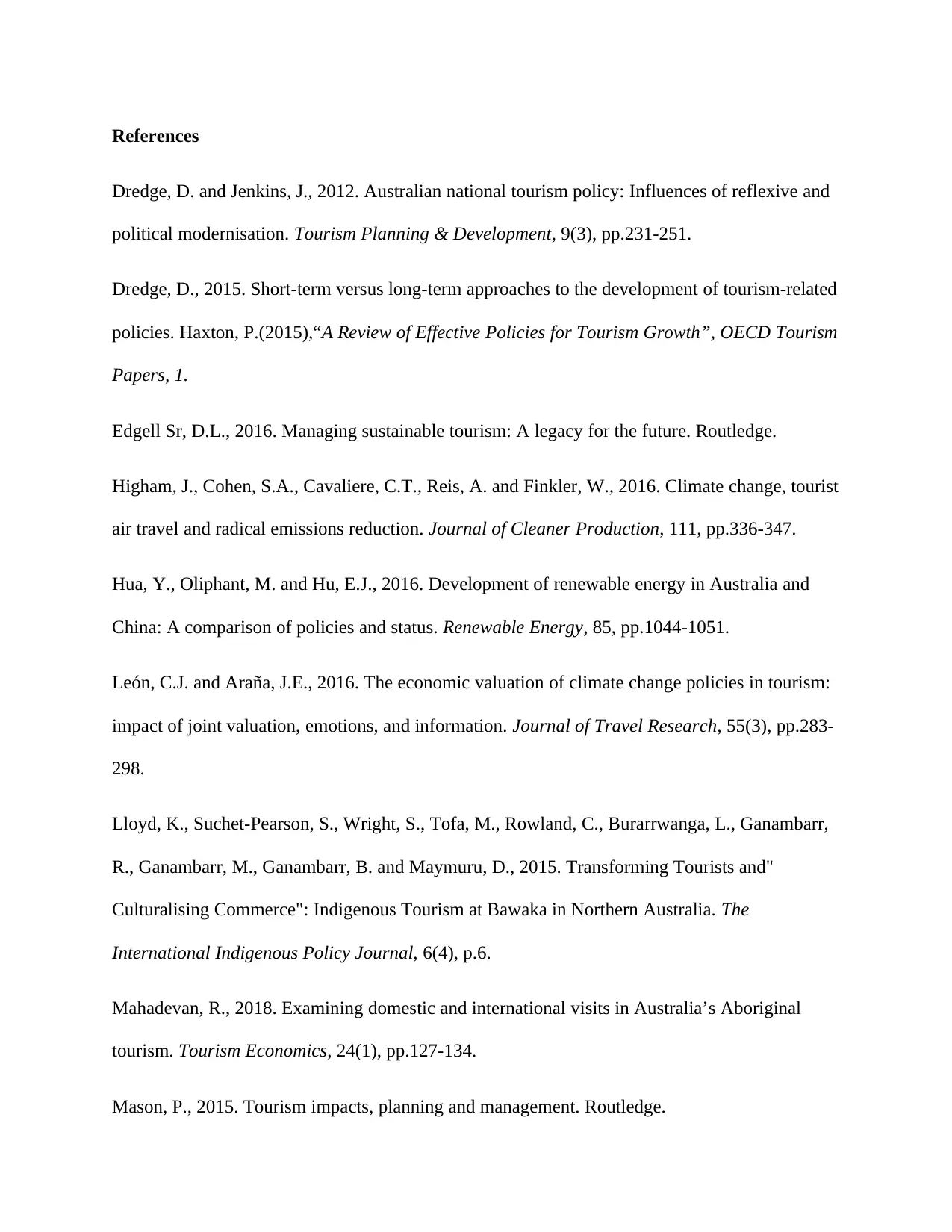
References
Dredge, D. and Jenkins, J., 2012. Australian national tourism policy: Influences of reflexive and
political modernisation. Tourism Planning & Development, 9(3), pp.231-251.
Dredge, D., 2015. Short-term versus long-term approaches to the development of tourism-related
policies. Haxton, P.(2015),“A Review of Effective Policies for Tourism Growth”, OECD Tourism
Papers, 1.
Edgell Sr, D.L., 2016. Managing sustainable tourism: A legacy for the future. Routledge.
Higham, J., Cohen, S.A., Cavaliere, C.T., Reis, A. and Finkler, W., 2016. Climate change, tourist
air travel and radical emissions reduction. Journal of Cleaner Production, 111, pp.336-347.
Hua, Y., Oliphant, M. and Hu, E.J., 2016. Development of renewable energy in Australia and
China: A comparison of policies and status. Renewable Energy, 85, pp.1044-1051.
León, C.J. and Araña, J.E., 2016. The economic valuation of climate change policies in tourism:
impact of joint valuation, emotions, and information. Journal of Travel Research, 55(3), pp.283-
298.
Lloyd, K., Suchet-Pearson, S., Wright, S., Tofa, M., Rowland, C., Burarrwanga, L., Ganambarr,
R., Ganambarr, M., Ganambarr, B. and Maymuru, D., 2015. Transforming Tourists and"
Culturalising Commerce": Indigenous Tourism at Bawaka in Northern Australia. The
International Indigenous Policy Journal, 6(4), p.6.
Mahadevan, R., 2018. Examining domestic and international visits in Australia’s Aboriginal
tourism. Tourism Economics, 24(1), pp.127-134.
Mason, P., 2015. Tourism impacts, planning and management. Routledge.
Dredge, D. and Jenkins, J., 2012. Australian national tourism policy: Influences of reflexive and
political modernisation. Tourism Planning & Development, 9(3), pp.231-251.
Dredge, D., 2015. Short-term versus long-term approaches to the development of tourism-related
policies. Haxton, P.(2015),“A Review of Effective Policies for Tourism Growth”, OECD Tourism
Papers, 1.
Edgell Sr, D.L., 2016. Managing sustainable tourism: A legacy for the future. Routledge.
Higham, J., Cohen, S.A., Cavaliere, C.T., Reis, A. and Finkler, W., 2016. Climate change, tourist
air travel and radical emissions reduction. Journal of Cleaner Production, 111, pp.336-347.
Hua, Y., Oliphant, M. and Hu, E.J., 2016. Development of renewable energy in Australia and
China: A comparison of policies and status. Renewable Energy, 85, pp.1044-1051.
León, C.J. and Araña, J.E., 2016. The economic valuation of climate change policies in tourism:
impact of joint valuation, emotions, and information. Journal of Travel Research, 55(3), pp.283-
298.
Lloyd, K., Suchet-Pearson, S., Wright, S., Tofa, M., Rowland, C., Burarrwanga, L., Ganambarr,
R., Ganambarr, M., Ganambarr, B. and Maymuru, D., 2015. Transforming Tourists and"
Culturalising Commerce": Indigenous Tourism at Bawaka in Northern Australia. The
International Indigenous Policy Journal, 6(4), p.6.
Mahadevan, R., 2018. Examining domestic and international visits in Australia’s Aboriginal
tourism. Tourism Economics, 24(1), pp.127-134.
Mason, P., 2015. Tourism impacts, planning and management. Routledge.

Mowforth, M. and Munt, I., 2015. Tourism and sustainability: Development, globalisation and
new tourism in the third world. Routledge.
Ruhanen, L., Whitford, M. and McLennan, C.L., 2015. Indigenous tourism in Australia: Time
for a reality check. Tourism Management, 48, pp.73-83.
Seiver, B. and Matthews, A., 2016. Beyond whiteness: a comparative analysis of representations
of Aboriginality in tourism destination images in New South Wales, Australia. Journal of
Sustainable Tourism, 24(8-9), pp.1298-1314.
Vila, T.D., Darcy, S. and González, E.A., 2015. Competing for the disability tourism market–a
comparative exploration of the factors of accessible tourism competitiveness in Spain and
Australia. Tourism Management, 47, pp.261-272.
new tourism in the third world. Routledge.
Ruhanen, L., Whitford, M. and McLennan, C.L., 2015. Indigenous tourism in Australia: Time
for a reality check. Tourism Management, 48, pp.73-83.
Seiver, B. and Matthews, A., 2016. Beyond whiteness: a comparative analysis of representations
of Aboriginality in tourism destination images in New South Wales, Australia. Journal of
Sustainable Tourism, 24(8-9), pp.1298-1314.
Vila, T.D., Darcy, S. and González, E.A., 2015. Competing for the disability tourism market–a
comparative exploration of the factors of accessible tourism competitiveness in Spain and
Australia. Tourism Management, 47, pp.261-272.
1 out of 9
Related Documents
Your All-in-One AI-Powered Toolkit for Academic Success.
+13062052269
info@desklib.com
Available 24*7 on WhatsApp / Email
![[object Object]](/_next/static/media/star-bottom.7253800d.svg)
Unlock your academic potential
© 2024 | Zucol Services PVT LTD | All rights reserved.
